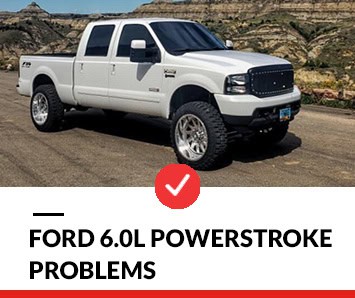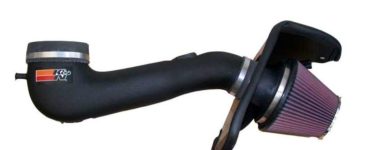6.0L Powerstroke problems: Most common ones
The Ford 6.0L Powerstroke has a very interesting reputation but people who go through the motions really love this engine. The Ford 6.0L Powerstroke has become one of my favorite projects at work because it gives me something different to do and I enjoy doing machine repair and diagnostics. You will be a proud owner once you are familiar with how to maintain, repair, and acknowledge common problems or issues surrounding the Ford 6.0L Powerstroke engine.
The Ford 6.0L Powerstroke engine has a very interesting reputation but most people, once they’re familiar with the intricacies of this engine, have warmed to it and become proud owners. The Ford 6.0L Powerstroke engine is one my favorite projects at work–I’m not afraid to tell you that I love what I do (you too will be). Once you’re familiar with the engine and how it typically interacts both at home and on the job, rest assured that you’ll be a knowledgeable owner in no time.
For some history on the 6.0L Powerstroke engine, look at when it was introduced in 2003; replacing the 7.3L Powerstroke that put out only 275 horsepower and 525 foot pounds of torque. The 6.0L power stroke has an increased output of 325 hp and 570 ft./lbs., much due to improved turbocharger efficiency.

Powerstroke 6.0L: Basic Info and Specs
The 6.0l Powerstroke remains one of the most popular diesel tuner engines out there despite a slew of complaints about its reliability and performance. Some hypothesize that it is more reliable in the International version, VT365 because it does not have emission components necessitated by EPA regulations. The 6.0 Powerstroke has benefited from more advanced technology and meets emissions requirements initially, but Ford phased it out when they determined that the engine wouldn’t meet stricter emissions demands.
- Production Run: 2003 – 2009
- Cylinder Head Material: Cast Iron
- Cylinder Block Material: Cast Iron
- Configuration: V8
- Bore: 95mm
- Stroke: 105mm
- Valvetrain: Single Cam – Pushrod – 32 Valves
- Displacement: 6.0L
- Weight: 966lbs Wet
- Compression Ratio: 18:1
- Max HP: 325hp
- Max LB-FT: 570lb-ft
Powerstroke 6.0L: Applications
As you probably already know, Ford originally used the 6.0L Powerstroke in its medium and heavy-duty vehicles. You can also switch this engine into all sorts of different vehicles – from trucks to boats.
- 2004 – 2010 Ford E-Series Vans
- 2003 – 2005 Ford Excursion
- 2003 – 2007 Ford F-Series
6.0L Powerstroke Problems
The 6.0L Power Stroke engine has become a popular option among truck owners who are looking for more power from their diesel trucks. It was an amazing new design, even when you compare it to the old 7.3L models offered in 2003; it pumps out quicker turbo response, with highly advanced features like variable geometry on both intake and exhaust valves (that reduce emissions). International’s new 6.0L Power Stroke engine fell short of the competition in terms of power and fuel efficiency, but this became irrelevant as the engine was recalled on multiple occasions for technical service bulletins
A class action lawsuit has resulted from the many problems that arise frequently. There are claims, though it is debatable if there truly is any significance between model year and reliability. A common perspective is that the 6-liter engine was hit or miss. The engine undeniably ran more temperamental than diesel owners expected. The good news is that most trucks on the road today have received adequate repair and/or have updated parts, and therefore are less prone to future failures. Problems typically arise quickly, early in the truck’s life cycle, and many of these problems were addressed before they became a concern for drivers. We hope this information helps current 6.0L Powerstroke owners and prospective buyers best understand -diagnose,- prevent reliability issues for current models.
Note: Problems are not listed in numerical order, but problems encountered by customers with 6.0-liter Powerstroke engines generally fall into one of three categories: reliability issues, fuel economy/emissions/fuel filter concerns or warranty related items.
6.0L Powerstroke Stuck Turbo
The perfect solution to a stuck turbo on a 6.0L truck is not letting it idle for long periods and driving aggressively from time to time. A loud flutter after accelerating or an underboost/overboost code are also symptoms of a malfunctioning turbo.
Most turbochargers can be salvaged without replacement! An easy fix is to remove and clean your turbo, some replacement o-rings are required. If the turbo is leaking excessive oil or has excessive shaft play, replacement of the turbocharger could be required. Other overboost situations can be caused by modification of PCMs or tuners.
TTY Head Bolts
6.0L Powerstroke cylinder heads are secured to the engine block using torque-to-yield bolts. These threaded fasteners are a once use component: once they’re stretched when securing pressure is applied, they must be replaced if removed from the assembly process. Longevity presents a problem in stock engines with no aftermarket upgrades; however, increased pressures may cause head gasket failures in modified machines as well. Additional 6.0L Powerstroke Problems include EGR system contribution to head bolts’ yield point and properties which cause increased cylinder head temperatures. The solution is to install aftermarket studs or bolts in place of factory ones, as well as new head gaskets for any performance modifications.
EGR Valves & EGR Coolers
6.0L Powerstroke EGR valves and EGR coolers are commonly a cause for concern. The exhaust gas recirculation (EGR) valve is an emissions device that controls the amount of exhaust gases that are reintroduced into the engine, effectively diluting the intake charge to reduce NOx emissions. The EGR cooler is a heat exchanger that cools exhaust gases before reintroducing them into the engine. When these systems work, they result in higher than optimal operating temperatures – especially under load.
EGR coolers are found on short trucks and 2003 model year Power Strokes. The EGR coolers have also been known to fail and leak coolant into the exhaust system (white smoke is typically noticed coming from the exhaust, which is steam). Soot builds up in the cooler over time; when it does, the excessive heat can boil coolant in the exchanger.
The EGR valves may clog and fail to open or close, leading to problems with power. Poor fuel quality will also cause a buildup on the EGR valve that can worsen its function after time. To keep it functioning properly, clean the valve at every oil change other than ADL and replace your 2004-2007 MY engine’s oil cooler when needed.
Installing an EGR kit tends to show their own set of problems, such as leakage at the hose. If you think your oil cooler or EGR needs replacement, do an intake repair for maximum efficiency.
If the EGR valve is clean, you may experience lower gas mileage and poor engine performance. The contributing factors are typically idling or using high-sulfur fuel. Check out OEM EGR Valve Gasket set if you need a new EGR valve.
Oil Cooler Failure
One downside to the 6.0L PowerStroke engine is that it can be expensive to replace oil coolers, which sometimes clog because of residue sand in the mold when they’re cast and because poor quality oil can also cause places for dirt or grime to collect. Ford recommends changing your engine oil and coolant at their recommended intervals to reduce the chance for a funk due to fine metallic particles or degraded gasket material. You may also want an aftermarket car coolant filter to remove particles from the engine cooling system, especially if you go off-roading on a regular basis — it’s up there with air filters as something people should check every 50k miles just in case.
6.0L Powerstroke FICM Failure
The Fuel Injection Control Module is the electronic component that resides on the driver side valve cover of the 6.0L Power Stroke. The FICM is bound to “burn up” at some point, but engine heat and vibrations can contribute to premature failures in this module. 6.0L Powerstroke FICM failures cause rough running, no start, hard starts and stalling. The FICM can be tested before being replaced and if it needs to be rebuilt from a company with professional warranty on repairs—consider having them rebuild your 6.0L Powerstoke for high quality longevity at low costs.
ICP & IPR Sensor Failures
The ICP (injection control pressure) sensor relays oil pressure in the high-pressure oil rail. The IPR (injection pressure regulator) is located on the back of the high-pressure oil pump and controls the power pressure for this system. Both sensors have been known to fail prematurely. To our knowledge, new parts from Ford are most recently upgraded, and not problematic.
Sticking HEUI Injectors
In a traditional HUI injector, pressurized engine oil is used to feed fuel into the injection cylinder, whereas in CR tech, an implosion process sends high pressure gas down where it causes an equal and opposite reaction of linear motion. This results in near instantaneous high-pressure processing of the fuel that makes for more efficient combustion than an oil injected system and better emissions control. Ford’s 6.0L engine has inherent issues with its injector components, specifically related to stiction. If you have an older truck which is on the list of eligible models (as found in this post), your best option is regular injection component maintenance and using a treatment additive that provides protection against scticture – we recommend Archoil AR9100 friction modifier or Hot Shot’s Secret Stiction Eliminator products for this purpose.
High Pressure Oil Pump Failure
The HPOP (high pressure oil pump) on the 6.0L Power Stroke engine has been known to malfunction, from a leaky seal to complete failure; it’s worth mentioning that this is a wear item and as such is expected to need replacing at some point regardless of normal use. The 6.0L Powerstroke is known for needing replacement sooner than most engines of the three. Electronic diagnostic equipment can be used to verify whether or not the pump is operating within spec. When you have a load on, oil pressure has to read between 3,000 and 4,000psi in order for your engine to function properly. When idling it drops down around 600-700 psi range but should maintain 500psi in order for your engine to keep running.
Wire Harness Chafing
One of the most common causes for a truck with hard starting, no-starting and electrical problems is chafing in the wiring harness. Wires that vibrate against brackets, corners or components that they are secured to will wear down their lining and ground when they come into contact with something conductive like metal. Look for wire chafing by following wires as closely as possible while paying close attention to where wires run tightly against other things or brackets.
Oil Rail & Plug Leaks
The 6.0L Power Stroke, a model of Ford pickup truck popular with over 145,000 commercial fleets and car rental companies world-wide, frequently suffers from oil-seal failure in the high pressure oil rail system.
The issue often manifests as rough engine operation, stalling or a no hot start condition with trouble codes P2284 (California) or P2290 (Canada) involving crankcase ventilation not reaching one thousand rpm within two seconds after throttle opening when starting cold. While there’s uncertainty about why this happens at such rates to these vehicles on the factory issued 5w20 motor oils they are unfortunately sold running on today for now and into 2010 without considering climate change which is expected to increase warranty claims dramatically on this already problematic.
6.0L Powerstroke Stuck Turbo
There are common problems with the variable-vane turbo on these engines, one of which is that it will become stuck. A stuck, or jammed, turbo can cause a loss in power or change your boost from good to sluggish. To prevent this from happening, you should not idle the vehicle for an extended period of time. That also means to keep driving it so that the turbo can work hard. Other symptoms of a stuck 6.0L turbo include a loud flutter after acceleration.
Turbochargers are one part of the powertrain that typically don’t need to be replaced. One fix is to simply remove and clean it–you’ll probably need replacement rings on there, though, as well as an overboost situation from a PCM or tuner modification.
The Ford 6.0L Powerstroke has a very interesting reputation but people who go through the motions really love this engine. The Ford 6.0L Powerstroke has become one of my favorite projects at work because it gives me something different to do and I enjoy doing machine repair and diagnostics. You will be a proud owner once you are familiar with how to maintain, repair, and acknowledge common problems or issues surrounding the Ford 6.0L Powerstroke engine.
The Ford 6.0L Powerstroke engine has a very interesting reputation but most people, once they’re familiar with the intricacies of this engine, have warmed to it and become proud owners. The Ford 6.0L Powerstroke engine is one my favorite projects at work–I’m not afraid to tell you that I love what I do (you too will be). Once you’re familiar with the engine and how it typically interacts both at home and on the job, rest assured that you’ll be a knowledgeable owner in no time.
For some history on the 6.0L Powerstroke engine, look at when it was introduced in 2003; replacing the 7.3L Powerstroke that put out only 275 horsepower and 525 foot pounds of torque. The 6.0L power stroke has an increased output of 325 hp and 570 ft./lbs., much due to improved turbocharger efficiency.

6.0L Powerstroke problems: Basic Info and Specs
The 6.0l Powerstroke remains one of the most popular diesel tuner engines out there despite a slew of complaints about its reliability and performance. Some hypothesize that it is more reliable in the International version, VT365 because it does not have emission components necessitated by EPA regulations. The 6.0 Powerstroke has benefited from more advanced technology and meets emissions requirements initially, but Ford phased it out when they determined that the engine wouldn’t meet stricter emissions demands.
- Production Run: 2003 – 2009
- Cylinder Head Material: Cast Iron
- Cylinder Block Material: Cast Iron
- Configuration: V8
- Bore: 95mm
- Stroke: 105mm
- Valvetrain: Single Cam – Pushrod – 32 Valves
- Displacement: 6.0L
- Weight: 966lbs Wet
- Compression Ratio: 18:1
- Max HP: 325hp
- Max LB-FT: 570lb-ft
Powerstroke 6.0L: Applications
As you probably already know, Ford originally used the 6.0L Powerstroke in its medium and heavy-duty vehicles. You can also switch this engine into all sorts of different vehicles – from trucks to boats.
- 2004 – 2010 Ford E-Series Vans
- 2003 – 2005 Ford Excursion
- 2003 – 2007 Ford F-Series
6.0L Powerstroke problems
The 6.0L Power Stroke engine has become a popular option among truck owners who are looking for more power from their diesel trucks. It was an amazing new design, even when you compare it to the old 7.3L models offered in 2003; it pumps out quicker turbo response, with highly advanced features like variable geometry on both intake and exhaust valves (that reduce emissions). International’s new 6.0L Power Stroke engine fell short of the competition in terms of power and fuel efficiency, but this became irrelevant as the engine was recalled on multiple occasions for technical service bulletins
A class action lawsuit has resulted from the many problems that arise frequently. There are claims, though it is debatable if there truly is any significance between model year and reliability. A common perspective is that the 6-liter engine was hit or miss. The engine undeniably ran more temperamental than diesel owners expected. The good news is that most trucks on the road today have received adequate repair and/or have updated parts, and therefore are less prone to future failures. Problems typically arise quickly, early in the truck’s life cycle, and many of these problems were addressed before they became a concern for drivers. We hope this information helps current 6.0L Powerstroke owners and prospective buyers best understand -diagnose,- prevent reliability issues for current models.
Note: Problems are not listed in numerical order, but problems encountered by customers with 6.0-liter Powerstroke engines generally fall into one of three categories: reliability issues, fuel economy/emissions/fuel filter concerns or warranty related items.
6.0L Powerstroke Stuck Turbo
The perfect solution to a stuck turbo on a 6.0L truck is not letting it idle for long periods and driving aggressively from time to time. A loud flutter after accelerating or an underboost/overboost code are also symptoms of a malfunctioning turbo.
Most turbochargers can be salvaged without replacement! An easy fix is to remove and clean your turbo, some replacement o-rings are required. If the turbo is leaking excessive oil or has excessive shaft play, replacement of the turbocharger could be required. Other overboost situations can be caused by modification of PCMs or tuners.
TTY Head Bolts
6.0L Powerstroke cylinder heads are secured to the engine block using torque-to-yield bolts. These threaded fasteners are a once use component: once they’re stretched when securing pressure is applied, they must be replaced if removed from the assembly process. Longevity presents a problem in stock engines with no aftermarket upgrades; however, increased pressures may cause head gasket failures in modified machines as well. Additional 6.0L Powerstroke Problems include EGR system contribution to head bolts’ yield point and properties which cause increased cylinder head temperatures. The solution is to install aftermarket studs or bolts in place of factory ones, as well as new head gaskets for any performance modifications.
EGR Valves & EGR Coolers
6.0L Powerstroke EGR valves and EGR coolers are commonly a cause for concern. The exhaust gas recirculation (EGR) valve is an emissions device that controls the amount of exhaust gases that are reintroduced into the engine, effectively diluting the intake charge to reduce NOx emissions. The EGR cooler is a heat exchanger that cools exhaust gases before reintroducing them into the engine. When these systems work, they result in higher than optimal operating temperatures – especially under load.
EGR coolers are found on short trucks and 2003 model year Power Strokes. The EGR coolers have also been known to fail and leak coolant into the exhaust system (white smoke is typically noticed coming from the exhaust, which is steam). Soot builds up in the cooler over time; when it does, the excessive heat can boil coolant in the exchanger.
The EGR valves may clog and fail to open or close, leading to problems with power. Poor fuel quality will also cause a buildup on the EGR valve that can worsen its function after time. To keep it functioning properly, clean the valve at every oil change other than ADL and replace your 2004-2007 MY engine’s oil cooler when needed.
Installing an EGR kit tends to show their own set of problems, such as leakage at the hose. If you think your oil cooler or EGR needs replacement, do an intake repair for maximum efficiency.
If the EGR valve is clean, you may experience lower gas mileage and poor engine performance. The contributing factors are typically idling or using high-sulfur fuel. Check out OEM EGR Valve Gasket set if you need a new EGR valve.
Oil Cooler Failure: 6.0L Powerstroke problems
One downside to the 6.0L PowerStroke engine is that it can be expensive to replace oil coolers, which sometimes clog because of residue sand in the mold when they’re cast and because poor quality oil can also cause places for dirt or grime to collect. Ford recommends changing your engine oil and coolant at their recommended intervals to reduce the chance for a funk due to fine metallic particles or degraded gasket material. You may also want an aftermarket car coolant filter to remove particles from the engine cooling system, especially if you go off-roading on a regular basis — it’s up there with air filters as something people should check every 50k miles just in case.
6.0L Powerstroke FICM Failure
The Fuel Injection Control Module is the electronic component that resides on the driver side valve cover of the 6.0L Power Stroke. The FICM is bound to “burn up” at some point, but engine heat and vibrations can contribute to premature failures in this module. 6.0L Powerstroke FICM failures cause rough running, no start, hard starts and stalling. The FICM can be tested before being replaced and if it needs to be rebuilt from a company with professional warranty on repairs—consider having them rebuild your 6.0L Powerstoke for high quality longevity at low costs.
ICP & IPR Sensor Failures
The ICP (injection control pressure) sensor relays oil pressure in the high-pressure oil rail. The IPR (injection pressure regulator) is located on the back of the high-pressure oil pump and controls the power pressure for this system. Both sensors have been known to fail prematurely. To our knowledge, new parts from Ford are most recently upgraded, and not problematic.
Sticking HEUI Injectors
In a traditional HUI injector, pressurized engine oil is used to feed fuel into the injection cylinder, whereas in CR tech, an implosion process sends high-pressure gas down it causes an equal and opposite reaction of linear motion. This results in near instantaneous high-pressure processing of the fuel that makes for more efficient combustion than an oil injected system and better emissions control. Ford’s 6.0L engine has inherent issues with its injector components, specifically related to stiction. If you have an older truck which is on the list of eligible models (as found in this post), your best option is regular injection component maintenance and using a treatment additive that provides protection against scticture – we recommend Archoil AR9100 friction modifier or Hot Shot’s Secret Stiction Eliminator products for this purpose.
High Pressure Oil Pump Failure
The HPOP (high pressure oil pump) on the 6.0L Power Stroke engine has been known to malfunction, from a leaky seal to complete failure; it’s worth mentioning that this is a wear item and as such is expected to need replacing at some point regardless of normal use. The 6.0L Powerstroke is known for needing replacement sooner than most engines of the three. Electronic diagnostic equipment can be used to verify whether or not the pump is operating within spec. When you have a load on, oil pressure has to read between 3,000 and 4,000psi in order for your engine to function properly. When idling it drops down around 600-700 psi range but should maintain 500psi in order for your engine to keep running.
Wire Harness Chafing
One of the most common causes for a truck with hard starting, no-starting and electrical problems is chafing in the wiring harness. Wires that vibrate against brackets, corners or components that they are secured to will wear down their lining and ground when they come into contact with something conductive like metal. Look for wire chafing by following wires as closely as possible while paying close attention to where wires run tightly against other things or brackets.
Oil Rail & Plug Leaks
The 6.0L Power Stroke, a model of Ford pickup truck popular with over 145,000 commercial fleets and car rental companies world-wide, frequently suffers from oil-seal failure in the high-pressure oil rail system.
The issue often manifests as rough engine operation, stalling, or a no hot start condition with trouble codes P2284 (California) or P2290 (Canada) involving crankcase ventilation not reaching one thousand rpm within two seconds after throttle opening when starting cold. While there’s uncertainty about why this happens at such rates to these vehicles on the factory-issued 5w20 motor oils they are unfortunately sold running on today for now and into 2010 without considering climate change which is expected to increase warranty claims dramatically on this already problematic.
6.0L Powerstroke Stuck Turbo
There are common problems with the variable-vane turbo on these engines, one of which is that it will become stuck. A stuck, or jammed, turbo can cause a loss in power or change your boost from good to sluggish. To prevent this from happening, you should not idle the vehicle for an extended period of time. That also means to keep driving it so that the turbo can work hard. Other symptoms of a stuck 6.0L turbo include a loud flutter after acceleration.
Turbochargers are one part of the powertrain that typically doesn’t need to be replaced. One fix is to simply remove and clean it–you’ll probably need replacement rings on there, though, as well as an over-boost situation from a PCM or tuner modification.
6.0L PSD Head Gasket Failure: 6.0L Powerstroke problems
Common 6.0L Powerstroke head gasket problems include torque-to-yield bolts and a small number of bolts per cylinder (4). It’s critical to inspect the engine for signs of damage before it’s too late: there is no warning from the engine, so you should not hesitate to take your truck in to get checked out. The head gaskets are most likely to fail when the boost level or injection timing is pushed too far. Head studs and new head gaskets are needed to increase the ability of the engine to handle this stress. Read my article Ford 6.0L Head Stud Installation for more information on what needs to be done in order to prevent a head gasket failure with a tuner.
6.0L Power Stroke & Performance Add-ons
A large number of 6.0L Powerstrokes have major problems when modified, especially if it requires tuning or programming changes. At this level, head studs are highly recommended and replacing the head gasket is also common. To avoid this issue, consider removing the EGR system and develop a plan for accepting much more power than stock with factory bolts where possible.
Structurally, these trucks can handle much more power than stock depending on the engine modifications used; make sure to accept all your modifications with factory-grade bolts where appropriate in order to avoid blowing out your engine anytime soon.
6.0L Powerstroke Coolant Leaking
Higher mileage 6.0L Powerstrokes have been known to leak coolant for unknown reasons, so first ensure that the EGR cooler and oil cooler have not been physically damaged. If so, you may have a head gasket in need of replacement, in which case you should replace them both at the same time or wait until your next scheduled engine service.




